Archive : Article / Volume 1, Issue 1
- Research Article | DOI:
- https://doi.org/10.58489/2836-5836/002
The association of autism with self injurious behaviors: An educational article
Advisor and expert trainer, Baghdad Medical City and the National Training and Development Center, Iraqi Ministry of Health, Baghdad, Iraq.
Aamir Jalal Al-Mosawi
Aamir Jalal Al-Mosawi (2022). The association of autism with self-injurious behaviors: An educational article. Journal of Clinical Trials and Bioavailability Research (JCTBR).1(1). DOI: 10.58489/2836-5836/002
© 2022 Aamir Jalal Al-Mosawi, this is an open access article distributed under the Creative Commons Attribution License, which permits unrestricted use, distribution, and reproduction in any medium, provided the original work is properly cited.
- Received Date: 09-12-2022
- Accepted Date: 20-12-2022
- Published Date: 26-12-2022
Self injury, autism, cerebrolysin, educational article.
Abstract
Background: Autism disorders which are also known pervasive developmental disorders as are very complex and heterogeneous group of chronic disorders that marked by early impairment in socialization, communication, and behavior. Although the occurrence of self-injurious behaviors has been reported as early as the 1970s, this association has not been adequately emphasized.
Patients and methods: The case of a 3.5-year Iraqi boy who has autism disorder and self injurious behaviors is described.
Results: A 3.5-year Iraqi boy was seen because of poor communication with others and poor speech development. At the clinic, the boy was not responding to name and had no eye contact, and it was like the doctor was not visible to him at all. He was also hyperactive and was trying to leave the room. The parents were also concerned about biting his hand especially when wanted to go outside home and the family prevented him.
The diagnosis of typical autism without significant mental retardation was made and the patient was initially treated with courses of intramuscular cerebrolysin based on our extensive published experiences with treatment of autism disorders.
Conclusion: In this paper, the association of self injurious behavior with autism disorder is emphasized, and the uncommon occurrence in association with autism sis order without significant mental retardation is described.
Introduction
Autism disorders which are also known pervasive developmental disorders as are very complex and heterogeneous group of chronic disorders that marked by early impairment in socialization, communication, and behavior. Autism disorders were first recognized by Grunya Efimovna Sukhareva (Figure-1A), a Soviet pediatric psychiatrist in 1925, and she called these disorders autistic psychopathy.
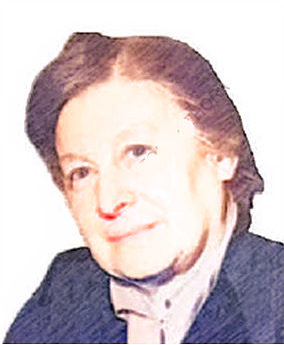
The characteristic and diagnostic manifestations of autism disorders result from impairments in social interaction and communication. The impaired social interaction causes the two major diagnostic features of autism which are the lack of eye contact, and the lack of appropriate responsiveness to own name. Difficulties in using and understanding language are an important feature of autism disorders. Repetitive body movements or behavior patterns including hand flapping, foot tapping, and spinning are commonly associated with autism disorders.
The Autistic disorder which is called classical autism was first described by Leo Kanner (Figure-1B) in 1943. The diagnostic feature of this type is normal or high intelligence.
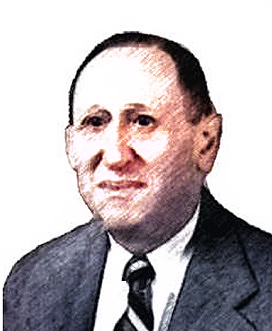
Children with Autism disorder who have subnormal intelligence, but without significant mental retardation are considered to have typical autism. The absence of significant mental retardation in such children is suggested by having acceptable adaptive behaviors including eating with spoon, bowel control and going to bathroom. In children with typical autism disorder, the serious lack of communication skills per se is expected to prevent or delay the acquisition of developmental mile stones.
Asperger syndrome was first described by Grunya Efimovna Sukhareva, and later by Hans Asperger (Figure-1C) in 1944 [1-7].
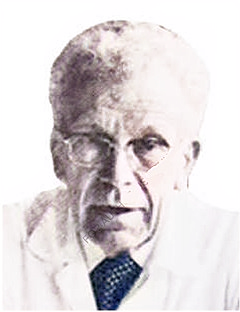
Although the occurrence of self-injurious behaviors has been reported as early as the 1970s, this association has not been adequately emphasized [8].
Patients and methods
The case of a 3.5-year Iraqi boy who has autism disorder and self injurious behaviors is described.
Results
A 3.5-year Iraqi boy was seen because of poor communication with others and poor speech development. At home he was not responding to name and had very poor eye contact (Figure-2A). He was also having repetitive movements and was sometimes hitting the floor until experiencing pain (Figure-2B).
He was repeating many words taught by his mother but was not using them satisfactorily to express his needs or to communicate with others.
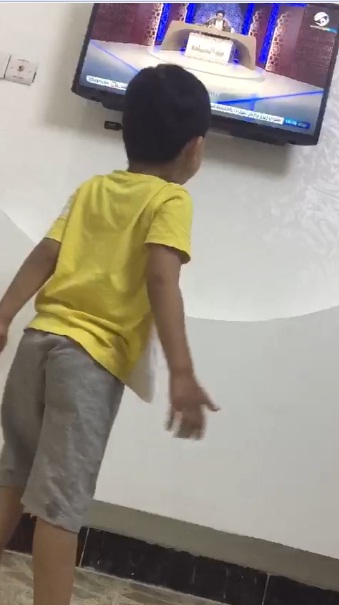

He was still unable to go the toilet by his own, and the parents were satisfied by his self-feeding ability (Figure-2C) despite he was eating sometimes things like rice by his hands and not using a spoon. He could use the pen to draw scribble and lines and some circular figures that are not that good (Figure-2D).
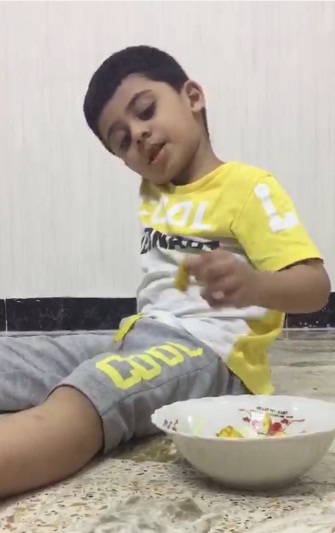
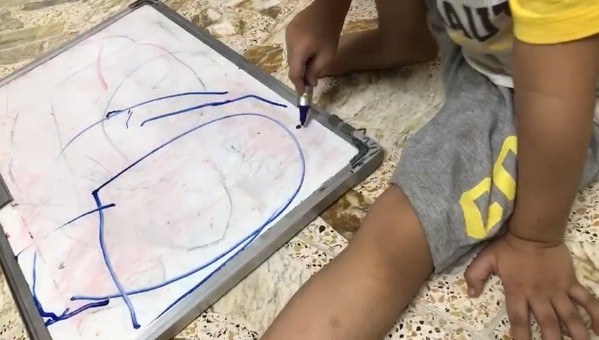
At the clinic, the boy was not responding to name and had no eye contact (Figure-3), and it was like the doctor was not visible to him at all. He was also hyperactive and was trying to leave the room.
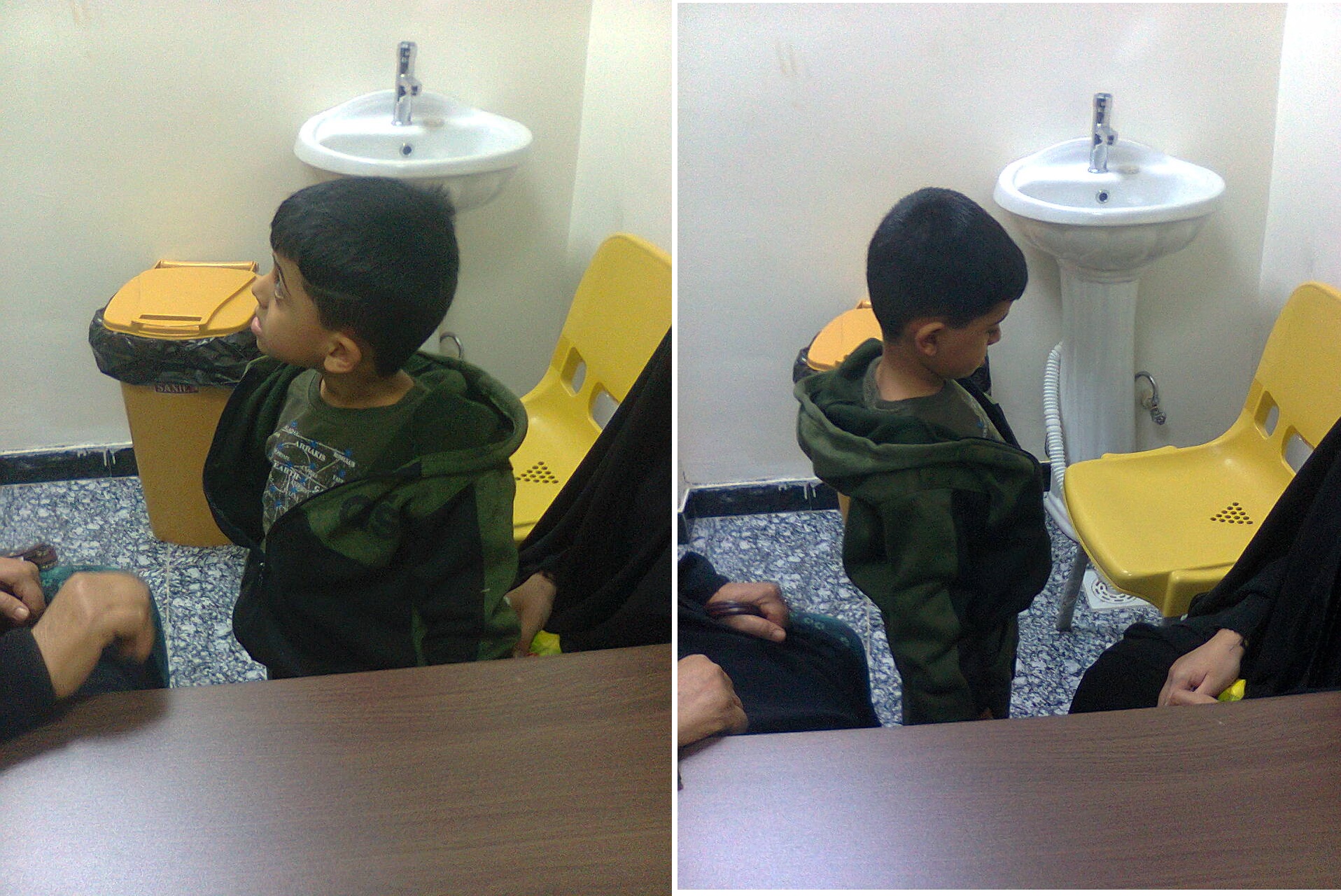
The parents were also concerned about biting his hand especially when wanted to go outside home and the family prevented him.
The diagnosis of typical autism without significant mental retardation was made and the patient was initially treated with courses of intramuscular cerebrolysin based on our extensive published experiences with treatment of autism disorders [9-15].
Discussion
Self-injury is a serious behavioral abnormality that is commonly reported in association with severe mental retardation, and it occurrence in association with autism without significant mental retardation is uncommon [5, 8, 16, 17, 18, 19, 20].
Recently, Malhi and Sankhyan (2021) studied the records of 1252 children with autism disorders and reported that about 22 % had self injurious behavior including head banging (47%), and self hitting (27.8%) [21].
Neufeld and Fantuzzo (1984) suggested the use of a protective plastic mouth shielding apparatus in the treatment of children with autism and severe self-biting behavior [18].
Walters (1990) reported a beneficial effect of naltrexone in the treatment of self-injury in a 14-yeal boy with autism and mental retardation [19]. Taylor et al (1991) reported that naltrexone markedly reduced self-injurious behavior in a 20-year-old male patient with autism and mildly mental retardation [20]. However, Knabe and colleagues (1990) reported an initial increase of self-injurious behavior in patients with autism disorders treated with naltrexone [23].
Gedye (1990) reported that trazodone reduced self-injurious and aggressive behaviors in a male patient with autism and mental retardation [21].
McCracken et al (2002) reported a placebo controlled, double-blind study of the use of risperidone in the treatment of 101 children (82 boys and 19 girls) aged 5 to 17 years, having autism disorder associated with severe tantrums, aggression, or self-injurious behavior. The study found that risperidone was beneficial for the treatment of tantrums, aggression, or self-injurious behavior in children, and was well tolerated [24].
This patient was initially treated with courses of intramuscular cerebrolysin based on our extensive published experiences with treatment of autism disorders [9-15].
Cerebrolysin, a safe parenteral mixture of aminoacids which has been used with a benefit in a variety of childhood neuropsychiatric disorders, is the only medical therapy that is known to be associated with significant improvement and even cure of the major autistic features (Poor response to name and poor eye contact which indicate impaired communication) [9-15].
Conclusion
In this paper, the association of self injurious behavior with autism disorder is emphasized, and the uncommon occurrence in association with autism disorder without significant mental retardation is described.
Acknowledgement
Some if the figures in this paper were included in previous author's publications, but the author has their copyrights.
The author would like to express his gratitude for the parents who willingly accepted publishing the photos of their child.
Conflict of interest: None.
References
- Al-Mosawi AJ. (2018).Asperger syndrome and regressive autism.1st ed., Saarbrücken; LAP Lambert Academic Publishing: (ISBN: 978-613-9-82643-8).
- Al-Mosawi AJ. (2018).A new therapeutic approach for pervasive developmental disorders. 1st ed., Saarbrücken; LAP Lambert Academic Publishing: (ISBN: 978-3-659-86602-9).
- Al-Mosawi AJ. (2018) Pediatric psychiatry: An accredited training course. 1st ed., Saarbrücken; LAP Lambert Academic Publishing: (ISBN: 978-613-9-86510-9
- Al-Mosawi AJ. (2019).The pattern of pervasive developmental disorders in Iraqi children.1st ed., Saarbrücken; LAP Lambert Academic Publishing: (ISBN: 978-3-330-05029-7).
- Al-Mosawi AJ. Autism disorders in Iraq. Scholars' Press: 2021 (ISBN-13: 978-613-8-94973-2, ISBN-10: 6138949730).
- Al-Mosawi AJ. (2020). Autism disorders: Cure is possible. 1st ed., Saarbrücken; LAP Lambert Academic Publishing, Saarbrücken; Germany, (ISBN-13:978-620-2-66617-6, ISBN-10: 620266617X).
- Al-Mosawi AJ. (2021). An introduction to child psychiatry: A training course. Scholars’ Press: (ISBN-13: 978-613-8-94954-1, ISBN-10: 6138949544).
- Jones FH.( 1974). An extinction procedure for eliminating self-destructive behavior in a 9-year-old autistic girl. J Autism Child Schizophr Sep; 4(3):241-50. Doi: 10.1007/BF0 2115230.
- Al-Mosawi AJ.( 2019). The use of cerebrolysin and citicoline in autism and Asperger syndrome. Journal of Bio Innovation (e-ISSN 2277-8330) January; 8(1): 99-108.
- Al-Mosawi AJ.( 2019). Pervasive developmental disorders in Iraqi children. Journal of Psychiatry Research Reviews & Reports Sep 11; 1(1): 1-8. Doi: 10.5281/zenodo. 4007395
- Al-Mosawi AJ.( 2020). Clinical uses of Cerebrolysin in Pediatric Neuropsychiatry. Science World Journal of Pharmaceutical Sciences February 5; 1(1): 1-4. Doi: 10.5281/ zenodo.3878485
- Al-Mosawi AJ.( 2020). Our experience with childhood pervasive developmental disorders (Autism and Asperger Syndrome): Cure is Possible. EC Clinical and Medical Case Reports March 03, 3(4): 08. Doi: 10.5281/zenodo.3892198
- Al-Mosawi AJ. Cure of autistic disorders: Mission impossible is possible in an illustrated pioneering experience. Archives of Health Science (ISSN 2641-7456) 4(1):1-26. 4(1):1-26. Doi: 10.31829/2641-7456/ahs2020-4 (1)-113
- Al-Mosawi AJ. (2021) Atypical Autism Associated with Elevated Gonadotrophin and Precious Puberty: A Very Rare Association or a New Clinical Syndrome? Biomedical Journal of Scientific & Technical Research (ISSN: 2574 -1241) 2021 Jan, 21; 33(2): 256 86-25689. Doi: 10.26717/BJSTR..33.005377
- Al-Mosawi AJ. (2021). A Novel Therapeutic Approach for Treating Rett Syndrome. EC Clinical and medical case reports March 01; 4(3): 1-9. Doi: 10.5281/zenodo.45686 52
- Al-Mosawi AJ. (2019). Pervasive developmental disorders in Iraqi children. Journal of Psychiatry Research Reviews & Reports Sep 11; 1(1): 1-8. Doi: 10.5281/zenodo. 4007395
- Al-Mosawi AJ. (2019). The etiology of mental retardation in Iraqi children. SunKrist Journal of Neonatology and Pediatrics. June 21; 1(1):1-9. Article No: sjnp-v1-1001. Doi:10. 46940/sjnp.01.1001
- Neufeld A, Fantuzzo JW. (1984). Contingent application of a protective device to treat the severe self-biting behavior of a disturbed autistic child. J Behav Ther Exp Psychiatry Mar; 15(1):79-83. Doi: 10.1016/0005-7916(84)90127-7
- Walters AS, Barrett RP, Feinstein C, Mercurio A, Hole WT. (1990). A case report of naltrexone treatment of self-injury and social withdrawal in autism. J Autism Dev Disord Jun; 20(2):169-76. Doi: 10.1007/BF02284716
- Taylor DV, Hetrick WP, Neri CL, Touchette P, Barron JL, Sandman CA. (1991). Effect of naltrexone upon self-injurious behavior, learning and activity: a case study. Pharmacol Biochem Behav Sep; 40(1):79-82. Doi: 10.1016/0091-3057(91)90324-u
- Gedye A. (1991). Trazodone reduced aggressive and self-injurious movements in a mentally handicapped male patient with autism. J Clin Psychopharmacol Aug; 11(4):275-6. Doi: 10.1097/00004714-199108000-00022
- Malhi P, Sankhyan N. (2021). Intentional Self Harm in Children with Autism. Indian J Pediatr. Feb; 88(2):158-160.Doi: 10.1007/s12098-020-03276-1
- Knabe R, Schulz P, Richard J. (1990). Initial aggravation of self-injurious behavior in autistic patients receiving naltrexone treatment. J Autism Dev Disord Dec; 20(4):591-3. Doi: 10.1007/BF02216064
- McCracken JT, McGough J, Shah B, Cronin P, Hong D, Aman MG, ( 2002) et al. Risperidone in children with autism and serious behavioral problems. N Engl J Med. Aug 1; 347 (5):314-21. Doi: 10.1056/NEJMoa013171


